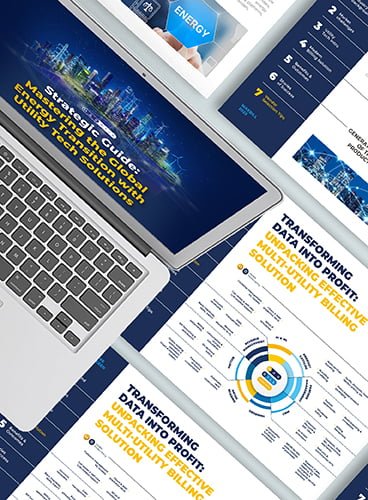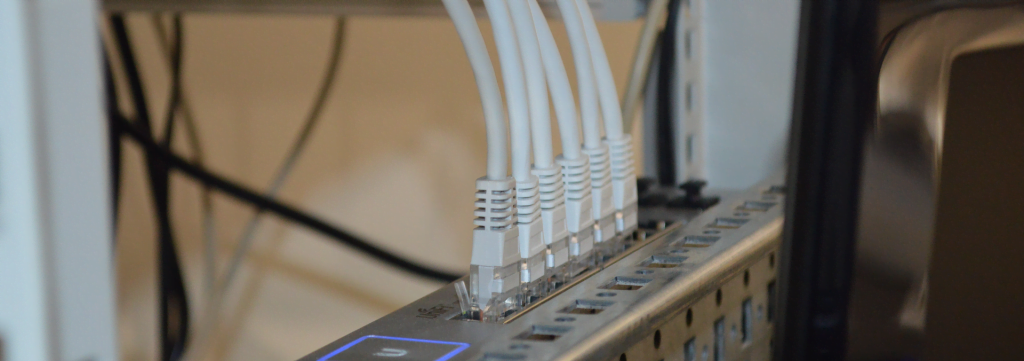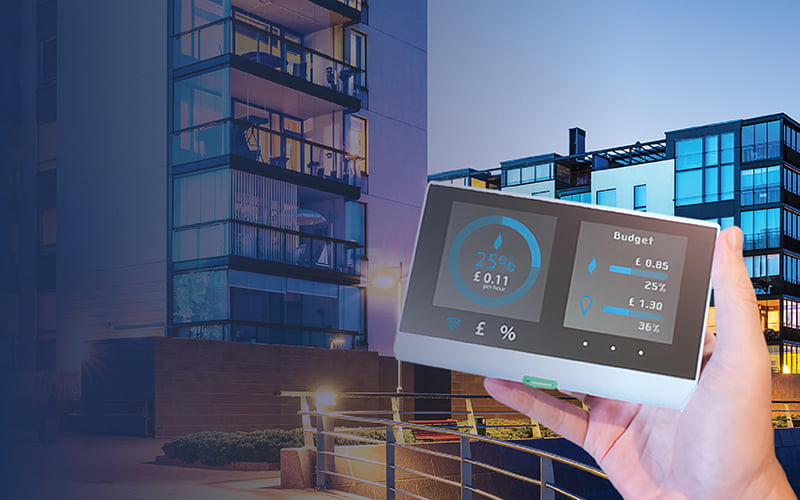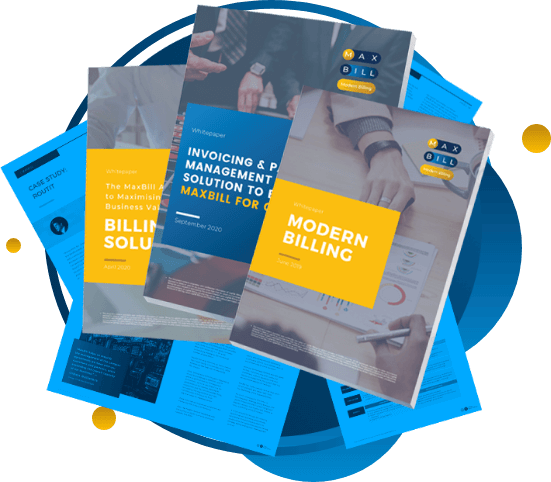June 25, 2025 (Updated)
Advanced, event-based CIS utility billing software is what will help utility companies meet evolving market demands today.
As utilities digitise, utility customer information systems are evolving to support a wider range of services beyond the traditional meter-to-cash cycle. This shift toward a ‘services-to-cash’ model needs innovative strategies to address customer expectations, such as dynamic pricing and new ways to maximize savings.
According to Research and Markets, the Customer Information System (CIS) market is expected to grow from $1.79 billion in 2025 to approximately $3.26 billion by 2030, which is equal to a compound annual growth rate of 12.8%.
In this piece, we’ll be exploring what modern CIS systems for utilities should be today to help utility companies meet modern market demands, increase the bottom line, and build the foundation for future resilience and stable growth.
Utility CIOs will get insights into what to do to make their company ready for the shifts around and for the innovations dictated by the competitive environment.
Let’s get started.
Key Takeaways
- A cloud-based solution is particularly efficient with data organisation, information segmentation, and relationship management.
- MaxBill CIS utility billing software delivers accurate billing, real-time updates, fast processing of consumer appeals, data consolidation, instant notifications, improved marketing campaigns, and transparency across ops and tasks.
- With MaxBill AI self-service portal, customers take control of their accounts, get the reports they need, and request additional services with an AI assistant.
- Modern solutions include dynamic pricing, innovative customer retention strategies, multi-utility services, and embedded AI models.
- When surveying CIS pay & bill software vendors, look for deep industry expertise, estimated ROI, and true co-design partnership.

What is CIS utility billing software?

A Customer Information System (CIS) software is a centralised hub for communicating with utility consumers and storing all data about servicing and payments. Its operation is ensured by special software packages that consider all the needs of the CIS billing system.
The following common functions are most often included in the scope of the technology:
- Customer communication;
- Meter reading management;
- Billing;
- Calculation of tariff plans;
- Connecting, disconnecting, or suspending the service;
- Accounts receivable and much more.
Summary: traditionally, utility CIS solutions are centralised hubs that contain all consumer data for effective comms, serving, and billing. Modern ones allow utilities to grow and support their expansion. However, they are not payment software for utilities and deliver more customer and revenue management.
What is CIS in utilities and billing?
“MaxBill CIS utility billing software ensures fast adoption to what utilities are developing today for their portfolio. Along with that, we support the expansion of cross-utility service delivery, customer base growth, and entry to new geographies.”
- Rost Bitterlikh, MaxBill VP of Research and Development
The CIS billing system collects all information about the consumed utility and calculates the cost of the service by tariff plans. Since the final price of the service depends on many factors, all of them should be considered when creating the invoice.
Consumers can see how the price they pay for utility companies’ services is formed. Thanks to the transparency of CIS billing and accurate accounting of utility consumption, trusting relationships between suppliers and customers will develop.
A modern CIS utility billing software differs significantly from the software of previous generations since it includes features not previously offered by providers:
- Customer notifications about changes in tariff plans, debts, special offers, etc.;
- Loan management for those clients who prefer to pay for utilities in installments;
- Interactive customer services for quick response to all customer requests or complaints;
- Customer relationship management (CRM) to manage personal consumer accounts and use them as a quick communication channel.
All these features are auxiliary to billing, but customer service will not be satisfactory without their effective implementation. Today’s consumers are accustomed to having direct access to service providers and all their consumption data. Utilities Customer Information Systems may set up this direct communication channel and provide billing transparency.
Summary: Utilities customer information systems builds trust between consumers and suppliers as the latter make invoices and customer management transparent. They put greater control into consumers’ hands today.
Find out about MaxBill CIS for energy and utlity:
How cloud-based CIS utility billing fits into your operations
The solution operates on the principle of a database. However, unlike traditional databases, all information in utility CIS billing is centralised, segmented, and unified. This allows you to get quick access to any blocks of information without separating it from the total mass of data.
In addition, CIS systems for utilities can be used to build predictive models using AI and ML tools. Here are just some of the key opportunities for integrating cloud-based CIS billing into the activities of utility companies.
Data organization
Utility companies serve many consumers, receiving regular streams of information about their meter data, payments, ordering services, changes in tariff plans, etc. Utilities customer information systems allow you to combine all this data and store it in the Cloud, having constant access not limited by company office hours.
As a result, customer service improves since company employees always have access to consumer data, no matter when they contact the support service through their accounts.
Information segmentation
Data segmentation is necessary to structure it to facilitate further processing. For example, if you want to predict debt risks, you need to work with information on late payments. However, information about meter readings will be irrelevant in this case. Thus, by segmenting information, you significantly facilitate the work of employees, saving on the time and effort required to implement each specific task.
Relationship management
Addressing customer concerns immediately is key to customer retention. If they have any questions, doubts, or difficulties, the company’s immediate response signals to them that all their problems will be resolved.
The advantage of utility customer information systems is that they offer a quick communication channel with company representatives. Moreover, many consumer questions disappear when they log into their account and see a detailed record of their consumption and payments.
Summary: cloud-based CIS utility billing solutions bring value for the way they organise data, segment it and empower relarionships management, it’s something traditional databases or CRM cannot do for utilities.
Related:
Cloud for Utilities: Migration Strategies & Value for Business
How MaxBill CIS utility billing software improves the customer experience

Customer satisfaction is more than just a nice bonus for utility providers. It is one of the key factors affecting a company’s profit, and it is no less important than timely bill payments.
This determines the importance of customer information systems for utilities, which become an effective platform for interaction with consumers. With the help of the CIS billing system, the utility provider can solve many current problems.
Accurate billing
An automated consumption accounting system and accurate billing help avoid misunderstandings and disagreements with consumers. The intermediary in the form of an employee who calculates the cost of the consumed utility, is excluded from CIS billing. Along with this, errors in billing also disappear.
Real-time updates
The lag between consuming the utility and receiving payment information disappears. The CIS system allows consumers to see their consumption figures and the price they must pay at any time. This eliminates possible distrust in the company and doubts about the final figures in the bills.
Fast processing of consumer appeals
The speed of communication with company representatives largely determines consumer satisfaction with its services. Any consumer may have questions, complaints, and suggestions. With the help of CIS billing systems, they will receive instant feedback and feel that their interests are respected.
Data consolidation
All client data will be stored in one place, which means no information about consumers’ payments or requests can be lost. In addition, CIS users will not have to enter the same data over and over again at the provider’s request. This also has a positive effect on the company’s image and clients’ positive attitudes towards it.
Improving marketing campaigns
Since utility companies’ employees will see all consumer data, they will be able to develop more personalized marketing campaigns. Using various filters that can be configured in CIS utility billing software, they will be able to identify the target audience they need and send them personalised offers.
Instant notifications
To effectively communicate with consumers, it is important to hear their requests and questions and talk to them. CIS billing systems provide a communication channel through which companies can instantly notify customers about tariff changes, preventive maintenance, debts, and other issues.
Visibility of all operations and tasks
Having access to the CIS billing system, company employees will see all current and unresolved tasks. These could be unpaid bills, requests to replace meters, doubts about the chosen tariff plan, etc. In this way, they will be able to respond more effectively to all requests or calls and confirm the image of the company as capable of solving all assigned tasks.
Summary: modern CIS for utilities by MaxBill reduce bill discpute and complaints rates, no lagging between consuming and charging, no data losses vs improved marketing campaigns, timely comms, visibility across customer and billing ops via reporting and dashboards.
Related:
Superior Utility Customer Experience By Transforming into a Customer-Centric Utility.
Beyond the Bill: Rethinking Customer Experience in Utilities 2024.
Utility customer experience: how automation tackles key challenges.
AI-driven self-service portal for utility customers by MaxBill
The self-service portal for utility customers by MaxBill is a powerful tool to give greater control to customers and make them loyal in general. It’s a channel of communication with people where you can educate them on energy usage, good practices, regulations, or other ‘what and why’ of a particular business.
At MaxBill, we went further and added an AI assistant.
The ‘digital guy’ is ready to help clients 24/7. It answers questions, explains invoices, walks through contract terms, helps submit requests, etc. There’s no need for human intervention while doing these activities.
The purpose is to help utilities reduce the workload of call centres, increase the productivity of customer-facing teams, and simply interact more efficiently with customers.
Summary: AI-powered self-care portal is what’s called “digital inclusion perfection” with AI agents communicating with customers.
How high-performing CIOs achieve technology optimisation within Customer Information System software
Business models evolve, and CIOs need to catch up. Here are the general tendencies that make utilities successful in the market:
- Utility CIS software enables the adoption of dynamic pricing, ensures regulatory compliance, and enables electric vehicle (EV) charging services.
- Dynamic Energy Contracts to Harness Price Volatility and Get Loyal Customers
- Half-Hourly Settlement: Is Your Utility Business ‘Reform-Able’?
- What Makes a Perfect EV Charging Billing Software & Revenue Settlement?
2. There’s a focus on customer retention through customised pricing strategies and a wider array of service options.
- How a Modern Multi-Utility Saas Billing Solution Transforms Multi-Utility Management For Greater Growth
- Innovative and Competitive Pricing Strategies for Energy and Utilities
- Product Catalog: Introduce New Products & Services Seamlessly!
3. The concept of service-to-cash emerged, offering a wide range of utility services, which comprises grid feed-ins, electric vehicle charging, net metering, time-of-use pricing and real-time pricing.
- What Is Net Metering, and How Does It Work?
- Smart Meter in Europe 2024-2030 to Transform Utilities and Empower Consumers.
4. CIOs leverage embedded AI models in modern CIS products to capitalise even more on offerings.
- A Churn Prediction Model for Utilities to Increase Customer Loyalty
- Machine Learning Debt Prediction Model for Utility Debt Recovery.
Summary: utility CIOs should forget about CIS systems that used to work as databases since energy transition, compliance, and customer demands require more agility to react to changes.
Utility customer information system integration for SME in energy and utility
MaxBill implements its own solution, which differs based on the client’s business requirements (including small, medium, and enterprise types of customers).
Related:
Removing the fear of utility CIOs about implementing modern SaaS billing and CIS solution.
The solution includes 7 modules and AI and ML-driven standalone solutions to deliver even more value. Recently, the team has added an AI-driven product catalog and billing – a new-gen of billing and contract creation that transforms the way how utility companies do business.
Now, it is up to 80% faster time-to-market, up to 30% of ops costs reduction, and zero errors when performing complex calculations.
Why choose MaxBill CIS pay & bill software?
In 2024, MaxBill was recognised by Gartner as a Representative Vendor in the 2024 Market Guide for Utility Customer Information Systems. We believe this is the perfect time to showcase what’s next for our AI billing and product catalogs.
So, why choose the solution?
1. Deep industry expertise. With over 29 years of exclusive focus on utilities and service providers, our solutions are grounded in real-world domain knowledge and best practices.
2. Immediate return on investment. MaxBill enables fast, measurable ROI from day one – helping clients move beyond endless pilot projects into real digital transformation.
3. A true co-design partnership. We don’t just deliver software. We collaborate closely with clients to build the long-term capabilities they need to succeed in a rapidly changing market.
Summary: When surveying utility CIS vendors, keep in 3 key criteria: references from the industry, estimated ROI, partneship promises.

CIS pay & bill software FAQ
What are the key features of CIS utility billing software?
Nowadays, on the energy and utility market, there are standard, must-have, and optional features of CIS pay & bill software. The must-have ones include revenue and account management, and meter-to-cash. However, provided there are new shifts in utility business models, automation, AI and ML, advanced analytics and reporting become indispensable.
How does CIS utility billing software improve customer satisfaction?
Modern CIS utility billing software comes with automation that removes inefficiencies in ops, which results in better service delivery and better communication with customers. Built-in AI and ML capacities allow creating a personalised experience for customers.
Can CIS utility billing software integrate with smart meters?
Absolutely, MaxBill CIS billing software supports meter reading from standard and smart meters
What are the benefits of using a self-service portal with CIS utility billing software?
The benefits of using a self-service portal with CIS for utilities are greater control over your energy usage, transparency over payments, communication with a service provider, etc.
How does CIS utility billing software handle billing and payment management?
CIS utility billing software handles billing and invoicing with automation for healthy cash flow, and supports standard bank payments and PSP interfaces.
































